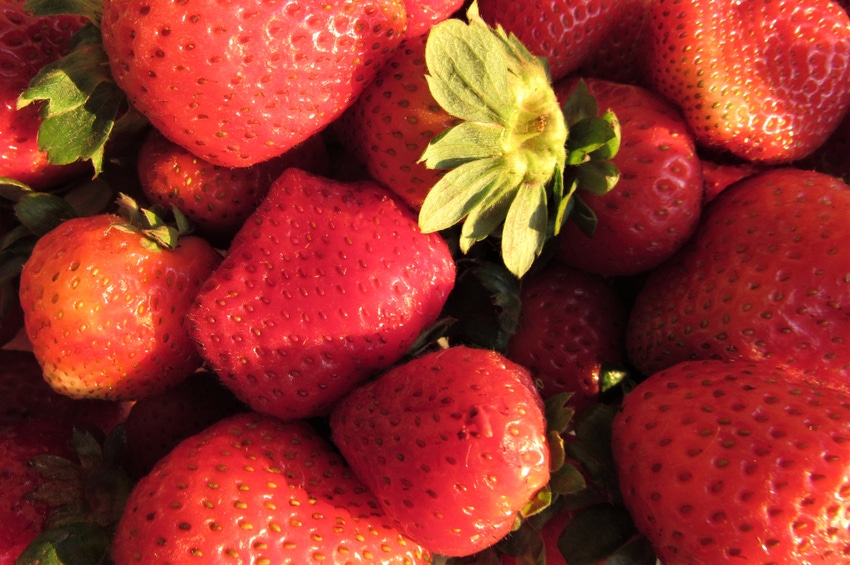
In recent years, California fresh strawberry growers often went into the holidays wondering if they would set another production record for the calendar year. But lately, they haven’t had to wait and wonder.
Despite a 12 percent decline in planted acreage over the last three years, the industry was assured of another production mark in 2018 by the last week of October. That’s when yields surpassed last year’s record total of 206 million crates brought in from fields.
Two years ago, strawberry farms in California – which provide nearly 80 percent of strawberries consumed in the U.S. – picked 196.8 million crates for the whole year. This year’s production was at 222.8 million trays as of mid-December, according to the California Strawberry Commission.
“We’re seeing more planting of the higher-yielding varieties,” commission spokeswoman Carolyn O’Donnell says. “Even though we had fewer acres planted this year compared to last year, those acres are being planted with higher-value varieties.”
ACREAGE DECLINES
The commission’s annual acreage survey released in early December predicts that berries for winter, spring and summer production will be harvested from 25,704 acres statewide in 2019, and that berry acreage for fall picking would total 6,010. That’s down from 31,640 acres and 6,460 acres, respectively, bearing strawberries in 2015.
The acreage drop reflects the increasing difficulty of producing strawberries amid persistent labor shortages and the elimination of methyl bromide. So growers are gravitating to more prolific varieties developed by the University of California Cooperative Extension, other agencies and private companies.
Among the more popular new varieties are the UC-developed Monterey and San Andreas strawberries, both of which are “day-neutral” varieties that are more tolerant of summer heat and more resistant to diseases.
Disease resistance is important to growers as methyl bromide was phased out of production fields by 2016. Farms have only two fumigants left for managing soil-borne plant pathogens – chloropicrin and Telone, both of which are facing increased scrutiny by state regulators.
ALTERNATIVE CONCEPTS
Among alternative concepts that scientists from the UC and elsewhere have been working on in recent years are raised bed troughs, “soilless” fields and anaerobic soil disinfestation. In 2017, a team of scientists based at UC-Santa Cruz received a $2.5 million USDA grant to further research biological soil disinfestation, crop rotation and other natural methods for fumigating soil, according to a strawberry commission news release.
“They’re definitely trying some other tools such as bio-pesticides in parts of fields,” O’Donnell says of growers. “Others have adopted anaerobic soil disinfestation. Certainly some of those methods have benefitted organic growers. They only had a four or five-year ground rotation as a way to avoid soil-borne diseases.
However, “we definitely do not have a one-size-fits-all approach compared to when methyl bromide was available,” she says.
Overall organic acreage in California has risen from 3,420 acres in 2015 to a projected 4,170 acres in 2019, the commission reports. However, UC scientists point out that organic growers still encounter such challenges as nutrient deficiency, for which they are unable to use the controlled-release fertilizers that conventional growers use.
INCENTIVE TO CHANGE
The industry has an incentive to move away from fumigants and synthetic fertilizers as much as possible. For the third year in a row, strawberries in 2018 topped the “Dirty Dozen” list of fruits and vegetables put out by the Environmental Working Group, an advocacy organization.
The group contends that conventionally grown strawberries tested by USDA scientists in 2015 and 2016 contained an average of 7.8 different pesticides per sample, compared to 2.1 pesticides per sample for all other produce. The scientists tested 1,174 batches of conventional strawberries – about 89 percent of which were grown in the U.S., with the rest coming from Mexico or, in the case of one batch, the Netherlands, according to an EWG news release.
The strawberry commission’s O’Donnell counters that the EWG’s report counts instances of pesticide residue without considering the level of risk to the consumer.
“That’s not meaningful, and it’s really not science-based,” she says.
In fact, residue levels in nearly all the fruit tested fell well below maximums set by the U.S. Environmental Protection Agency and the California Department of Pesticide Regulation, O’Donnell says. She worries that low-income consumers who can’t afford to buy organic strawberries will be confused by the EWG’s message.
“What they might do in low-income neighborhoods is choose not to buy any at all,” she says. “It’s causing people to make less than healthy choices when really we have a wholesome, healthy, safe supply of fruits and vegetables in this country.”
POPULARITY STRONG
However, strawberries have gained in popularity in recent years, with the fruit leading in volume and value in the berry category, which is the top-selling category in the produce department, the commission asserts.
Prices are continuing to reflect that popularity. On Dec. 20, a flat of eight 1-pound containers conventionally produced in Oxnard, Calif., averaged $25, up from $16 a year earlier, according to the commission. Organic strawberries from Santa Maria, Calif., averaged $32 per flat on Dec. 20, up from $27 a year earlier.
About the Author(s)
You May Also Like






